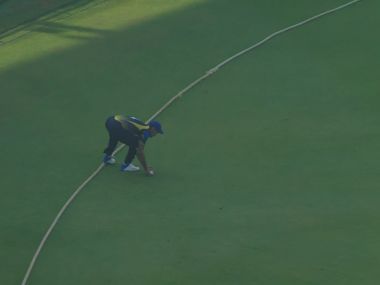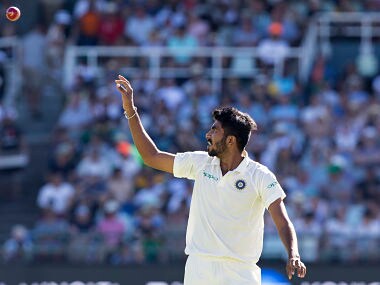India vs South Africa: Virat Kohli's men are not alone, all teams struggle to perform abroad
Australia, England, South Africa or India, who play like champions at home, look like lambs to the slaughter on tours. Hopefully, for India at least, with some luck and pluck, the second Test could bring gladder tidings.
Vedam Jaishankar, Jan,12 2018
- Pakistan in New Zealand, 5 ODI Series, 2018 NZ Vs PAK New Zealand beat Pakistan by 61 runs (D/L method)
- India in South Africa, 3 Test Series, 2018 SA Vs IND South Africa beat India by 72 runs
- The Ashes, 2017/18 AUS Vs ENG Australia beat England by an innings and 123 runs
- West Indies in New Zealand, 3 T20I Series, 2017/18 NZ Vs WI New Zealand beat West Indies by 119 runs
| Rank | Team | Points | Rating |
|---|---|---|---|
| 1 | India | 4969 | 124 |
| 2 | South Africa | 3888 | 111 |
| 3 | Australia | 4174 | 104 |
| 4 | New Zealand | 3489 | 100 |
| 5 | England | 4829 | 99 |
| 6 | Sri Lanka | 4058 | 94 |
| Rank | Team | Points | Rating |
|---|---|---|---|
| 1 | South Africa | 6386 | 120 |
| 2 | India | 6680 | 119 |
| 3 | Australia | 5948 | 114 |
| 4 | England | 6156 | 114 |
| 5 | New Zealand | 6109 | 113 |
| 6 | Pakistan | 4684 | 98 |
| Rank | Team | Points | Rating |
|---|---|---|---|
| 1 | New Zealand | 2262 | 126 |
| 2 | Pakistan | 2843 | 124 |
| 3 | India | 3385 | 121 |
| 4 | England | 2029 | 119 |
| 5 | West Indies | 2538 | 115 |
| 6 | South Africa | 2238 | 112 |





World Champions have no home grounds. That maxim might hold good for most sport. But cricket, which relishes every opportunity to take the mickey out of players, media, fans and experts alike, marches to a distinctly different tune.
The fallout from the loss to South Africa in the first Test at Cape Town led to understandable frustration among India’s legions of fans.
Indian captain Virat Kohli and his South African counterpart Faf du Plessis at the toss in Newlands. AP
Fans who had pegged hopes on this Indian team were naturally upset. The media fuelled the angst by berating the unwarranted series against Sri Lanka at home, lack of practice on bouncy tracks, absence of practice matches, presence of spouses and children on the tour, etc.
Some even went to the extent of terming the Indian team as bullies at home and wimps abroad.
Thousands of miles away, in the same southern hemisphere, England landed in Australian shores for The Ashes and did everything our experts claimed the Indians should have done in South Africa: land well in advance, have lot of practice on Aussie pitches, get acclimatised to the weather Down Under, play a series of tour matches, have wives and girlfriends over to celebrate Christmas and New Year, etc. Despite all this, England were whipped 4-0 in the five-match Ashes series.
The result followed the trend of Ashes being won by the home team, rather than the visitors. For instance, Australia lost in England a couple of years ago, just like England lost in Australia before that.
Closer home, India crushed a strong Australian team by two Tests to one last year. England suffered a worse drubbing — they lost 4-0, with India smashing them by an innings in Chennai and Mumbai.
But the same Australia and England teams won convincingly when India visited them. Even South Africa, when they came to Indian shores a couple of years ago, were trounced 3-0 in the four-Test series. Further, the South Africans started the Test series after a one-month stay in India, during which time they had played series of Twenty20 Internationals (T20Is), One-Day Internationals (ODIs) and tour matches. But even that sort of acclimatisation could not save them from a humiliating defeat.
In fact, over the last 50 years, only Clive Lloyd’s all-conquering West Indies team won everywhere, in England, Australia and India as well as at home. They had an amazing pack of fast bowlers and world class batsmen to back them.
Steve Waugh’s Australians too were a formidable team. But by Waugh’s own admission, India remained the final frontier.
So what makes formidable cricket teams lambs beyond their national boundaries? Other sports too are played on a home and away basis, but with no really discerning advantage being derived from playing at home. Getting acclimatised to the weather or altitude might be about the only variables that a team might have to contend with in a game like football, for instance.
In cricket, though, the big chasm is the complete absence of standardisation in choice of cricket ball, ground size, pitch or even weather conditions.
For long there was this issue of umpires too. But with the advent of neutral umpires, Decision Review System (DRS) and third umpire, that variable has been taken out of the equation. But the others remain, and sometimes insurmountably so.
On Indian pitches, for instance, spin is the big bugbear for overseas batsmen. They are not comfortable with using their feet to get to the pitch of the ball and this causes problems when the ball jumps and turns in hot and dry conditions.
Indian batsmen trust their eyesight, wrist and footwork so much that they even play against the spin and get away with it. Shane Warne found this to his utter amazement when on turning tracks Sachin Tendulkar and Navjot Singh Sidhu repeatedly hit him against the spin with great success.
But the same Indian batsmen struggle on Australian and South African pitches where the bounce is greater. They instantly find that their wrist play is of no use to deliveries bouncing above waist level. Additionally the 'sweet spot' on the bat confuses them and needs time getting used to. On Indian pitches, the 'sweet spot' is much lower and they get used to whacking the ball from that part of the bat. But in South Africa, when the ball bounces one to two inches higher from the same length, that spot becomes useless. Batsmen need to relearn to play higher.
The challenges in England are different. The ball swings and seams on softer pitches, with the cold, overcast conditions too harrying the visitors. English pitches do not have the steep bounce of Australia and South Africa, but the ball does swing and seam a lot more. This calls for a different set of skills.
Another variable is the choice of cricket ball. In England, they use Duke while the Australians settle for Kookaburra. India play with SG balls at home.
Duke is lighter, but with a pronounced seam. It swings a lot more than the Kookaburra with its flattened seam. The SG balls too have a good seam but lose shine pretty fast. They are ideal for reverse-swing and spin as the ball gets roughened pretty quickly.
In England and India most of the grounds are small in comparison to Australia and South Africa ones. The weather too is a factor and needs getting used to, as much in various parts of India as in England or Australia.
Big outfields call for strong shoulders for fielders to throw from the deep while batsmen have to learn to play powerful strokes that would cross or clear the fence. Some strokes, like the hook or cross-batted swat or lofted shots, are fraught with danger as they may not cross the vast boundaries.
India, like the English team Down Under, were aware of these issues. But call it habit or muscle memory or whatever, they could not get out of the mould in time.
Thus teams, whether Australia, England, South Africa or India, who play like champions at home look like lambs to the slaughter on tours. Hopefully, for India at least, with some luck and pluck, the second Test could bring gladder tidings.
Published Date:Jan 12, 2018
| Updated Date: Jan 12, 2018
Also See
India vs South Africa: Cheteshwar Pujara highlights importance of leaving the ball on bouncy pitches
India vs South Africa: Jasprit Bumrah's patchy debut raises fresh questions for Virat Kohli
India vs South Africa: Jasprit Bumrah says team 'doesn't deserve' to play Tests if their confidence is dented after one loss